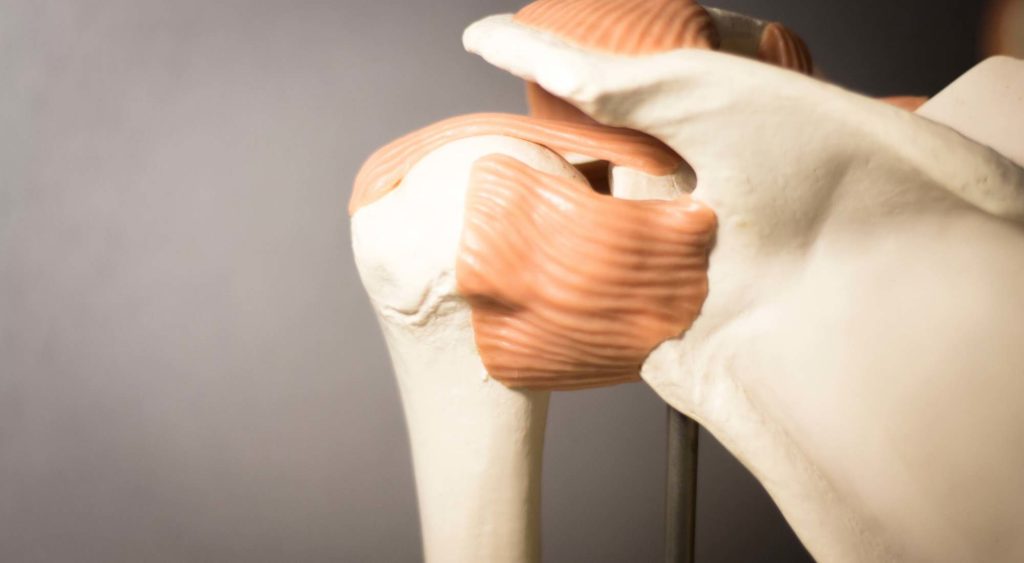Shoulder Bursitis Physical Therapy

Physical Therapy for Shoulder Bursitis – Information, Exercises, and More
Your life has been consumed with shoulder pain and discomfort.
After being diagnosed with shoulder bursitis, you’re looking for ways to manage the symptoms.
In Motion O.C. has you covered.
We understand how life-altering it can be to deal with significant amounts of pain daily. No one should have to stop doing the things they love due to an injury.
In this guide, we’re providing everything you need to know about shoulder bursitis, — what causes it, different treatments, and how physical therapy can help.

What is Shoulder Bursitis?
Shoulder bursitis is a painful inflammation and swelling of the shoulder joint. In shoulder bursitis, the bursae become inflamed and irritated.
Bursae are small fluid-filled sacs that act as cushions between moving parts in joints to stop bones, tendons, and muscles from rubbing together.
When these bursae become inflamed they get thicker—leaving little room for the muscles and tendons of the shoulder to move around.
Shoulder bursitis is the most common cause of shoulder pain in adults.
The subacromial bursa is the largest in the body. It is located below the large bony projection of the shoulder blade and is highly susceptible to bursitis.
What Causes Shoulder Bursitis?
Shoulder bursitis is usually caused by too much pressure or stress on the bursa. This stress is often triggered by repetitive movements that put pressure on the bursae of the shoulder.
Shoulder bursitis is divided into three categories:
- Chronic Bursitis
- Infected Bursitis
- Traumatic Bursitis
Chronic Bursitis
This type of bursitis develops over time due to repetitive irritation of the bursae in the shoulder.
With Chronic bursitis, there is usually no known cause but can occur due to pre-existing medical conditions that cause the bursa to swell.
Conditions like:
- Gout
- Pseudogout
- Diabetes
- Uremia
Infected Bursitis
Infected bursitis is also referred to as septic bursitis.
It occurs when the bursa becomes infected with bacteria. Bacteria can enter the bursa through a puncture, cut, or insect bite.
Infected bursitis is a serious condition that requires immediate medical attention.
Traumatic Bursitis
This is the least common type of shoulder bursitis and is most commonly found in athletes. It is typically caused by repetitive rubbing of an extremity or too much bending of a joint.
People who are most prone to shoulder bursitis are those who use their shoulders in overhead motions regularly like:
- Baseball players or other athletes
- Carpenters
- Musicians
Although it is most common in these situations, anyone can injure themselves and develop traumatic shoulder bursitis.
Shoulder Bursitis Symptoms
Symptoms of shoulder bursitis vary, but some of the most common symptoms include:
- Localized pain
- Tenderness
- Pain with motions of affected tissues
- Redness around the shoulder
- Sensitivity to pressure near the affected tissues
- Swelling — this is a very rare symptom of bursitis
Fever — specifically with infected bursitis
Shoulder Bursitis Treatment
Shoulder bursitis may or may not get better without any treatment.
Some conservative methods of shoulder bursitis treatment include:
- Rest
- Apply ice packs to the affected area
- Wear a shoulder brace
- Taking over the counter anti-inflammatory medicines
- Physical therapy
When these treatments don’t alleviate or reduce symptoms, further treatment may be necessary.
Non-Conservative Treatments
Non-conservative treatments are available for shoulder bursitis, although rarely needed. There are many treatments available including:
- Shoulder injections
- Ultrasound treatment
- Aspiration of Synovial Fluid From Shoulder
- Decompression surgery
If shoulder bursitis becomes chronic and left untreated, calcium deposits may begin to form in the soft tissues. This can result in permanent loss of movement in the area.
It’s important to contact your physician if you believe you may have shoulder bursitis in order to receive a diagnosis and develop a care plan.
Shoulder Bursitis Physical Therapy – Will PT Help?
In most cases, physical therapy for shoulder bursitis is extremely effective.
Physical therapy can reduce symptoms associated with bursitis, including:
- Pain
- Inflammation
- Weakness
- Swelling
By providing you with the best exercises to help improve your symptoms, your physical therapist can help improve your:
- Range of motion
- Posture
- Strength
- Endurance
If surgery is needed, your physical therapist can also help support you with a rehabilitation program after the procedure.
Best Shoulder Bursitis Exercises
Physical therapists will guide you through several exercises that will help with your bursitis symptoms or rehab after surgery.
Always consult with your Doctor of Physical Therapy before engaging in a new exercise program to ensure it is safe and appropriate for your condition. A few of the best bursitis exercises are provided below.
Scapular Active Range of Motion
This is one of the most common exercises recommended in shoulder bursitis physical therapy.
Scapular range of motion exercises should be done once or twice a day, as recommended by your doctor or physical therapist to regain the proper movement of your shoulder.
Strengthening Exercises
Shoulder strengthening exercises not only help relieve pain but can prevent future injuries from occurring.
With the guidance of your doctor or therapist, these strength training exercises can be done in your home at your own pace.
How In Motion O.C. Can Help With Shoulder Bursitis
In Motion O.C. physical therapists have helped dozens of patients resolve their symptoms of shoulder bursitis.
As the number one physical therapist in the United States on Yelp and Google, we are committed to providing the best care.
Your shoulders are some of the most used parts of the body. We know that there isn’t a one-size-fits-all treatment — especially when it comes to physical therapy.
Exercising is one of the best ways to recover from shoulder bursitis and overcome your injury.
Our team at In Motion O.C. will support you through the process, come up with a customized treatment plan, and teach you how to properly use your shoulders to reduce the risk of another injury.
*This information about physical therapy for shoulder bursitis was reviewed by Dr Natalie Thomas, PT, DPT. If you have any questions, please don’t hesitate to contact us here.


